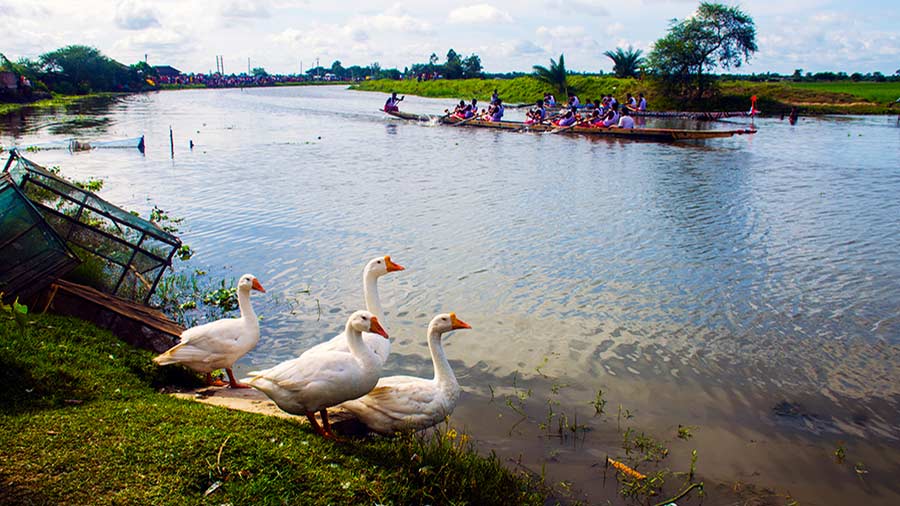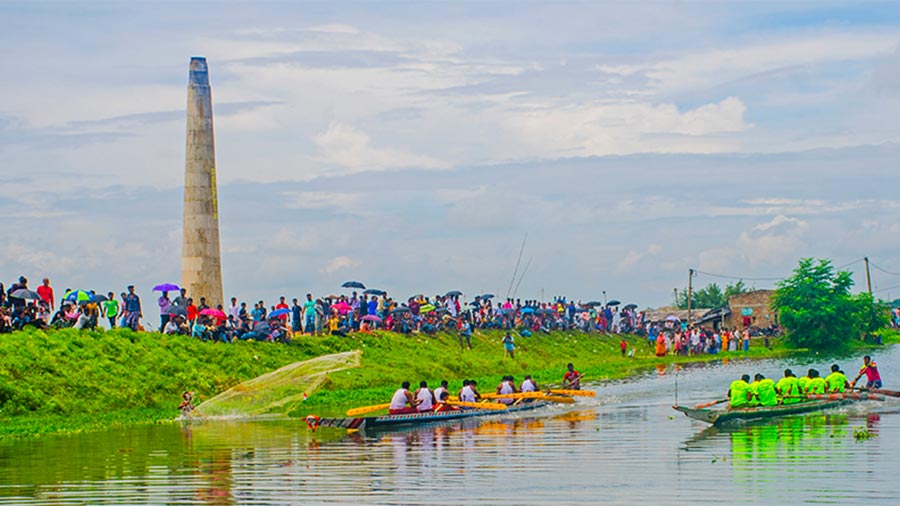You don’t have to go all the way to Kerala to witness a traditional boat race, you can cheer for one in a Canning village not more than 40km from Kolkata.
For the past eight years, the villagers of Ramamari and Gobramari in the Canning region of South 24-Parganas have been organising a boat race along Thakrun Khal (khal means canal), which meanders through the two villages. This year, the event was held on September 5 and 6 with six boats. The canal was narrow and could accommodate only two boats at a time. Locally known as baich khela, the competition was held in a league format with the top two teams advancing to the final.
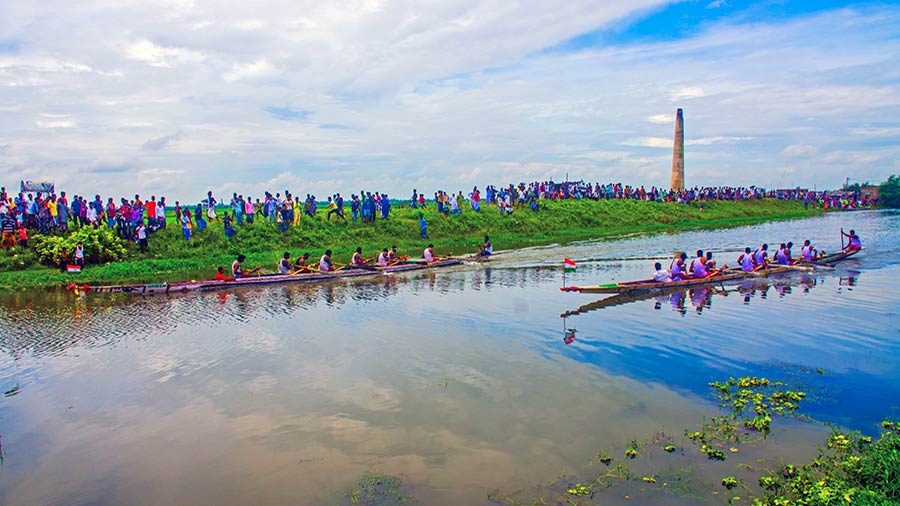
Thakrun Khal can only accommodate only two racing boats at a time
Rangan DattaSouthern Bengal is a land crisscrossed with rivers and rivulets and boats have played an integral part in shaping lives in this region. For centuries, boats have ferried people and goods across the complex network of waterways. Over the years, boats have evolved to serve specific purposes.
South Bengal has different types of boats depending on the cargo they handle and also the waterway through which they pass. Boats have not only been a form of transportation, but also a part of popular culture. Mohun Bagan club has a boat as its symbol. Boats are also a part of major celebrations and so are boat races at the end of the monsoon.

Boats have not only been a form of transportation, but also a part of popular culture in south Bengal. Mohun Bagan club has a boat in its logo
TT ArchivesAs the dark monsoon clouds are replaced by the feather-white clouds welcoming autumn, a fresh batch of paddy is planted and villagers have time on their hands. It is also the time when the ponds, lakes, rivers and canals are filled to the brim, reflecting the blue-and-white sky. What could be than celebrate by racing boats along the swelling rivers and canals?
With the development of the road and rail network, boats have taken a back seat. Boat racing has stopped in many of the villages of south Bengal. But a handful of villagers in a few villages are trying their best to bring back the age-old culture and are organising boat races just as their forefathers did.

The boats extend up to 60 feet in length and and three feet in width at the centre
Rangan DattaThe boats, locally called sarki, are long and narrow, and extend up to 60 feet in length and and three feet in width at the centre. The boats are rowed by eight rowers (locally called danri) with long, narrow oars that are rowed on alternate sides. The boat moves in the backward direction of the rowers. Sitting at the back end of the boat, and in the direction of the movement, is the hali, the man who steers the boat. The 10th person in the boat is called charandar, he is an official from the organising committee and looks out for any unfair play during the race.
Swarup Bhattacharyya, a fellow of the Anthropological Survey of India and a long-time researcher on Bengal’s wooden boats, said the hali is the most crucial member of the team. “He plays an important role in negotiating the sharp bends of the rivers or canals. These sarki boats have no practical utility and are only used for races,” he said.
Amiuddin Mollaha, whose boat participated in the race, seconds Bhattacharyya. “The boats are only for racing and yield no revenue. Moreover, the prize money doesn’t even cover the cost of preparation that includes the transportation of the boats to the race venue. It is only a time to make merry and it is more about participation than winning,” said Mollaha, who comes from the nearby village of Volaya. His boat is rowed by his nephews and the team was christened ‘Kaka Bhaipo, Volaya’.
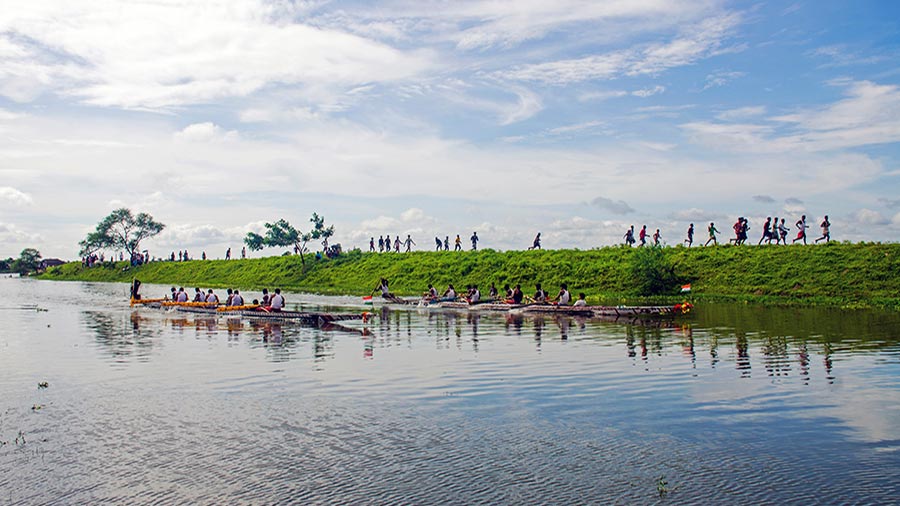
Spectators run along the bank, cheering the boats
Rangan DattaThe winning boat in this year’s race was called Churi and was owned by Hassan Mollah. The home team from Gobramari bagged the prize money of Rs 10,000.
The two days of the boat race is a festive time with makeshift stalls selling ice gola, freshly cut starfruit and guava, locally made kulfi malai and phuchka. In between the races, kids jumped and swam in the canal. Apart from the racing boats, other boats were rowed down the canal with men jumping out of them. The daily activities were also in progress and fishermen cast their nets on the edge of the canal while the boats raced down the middle.
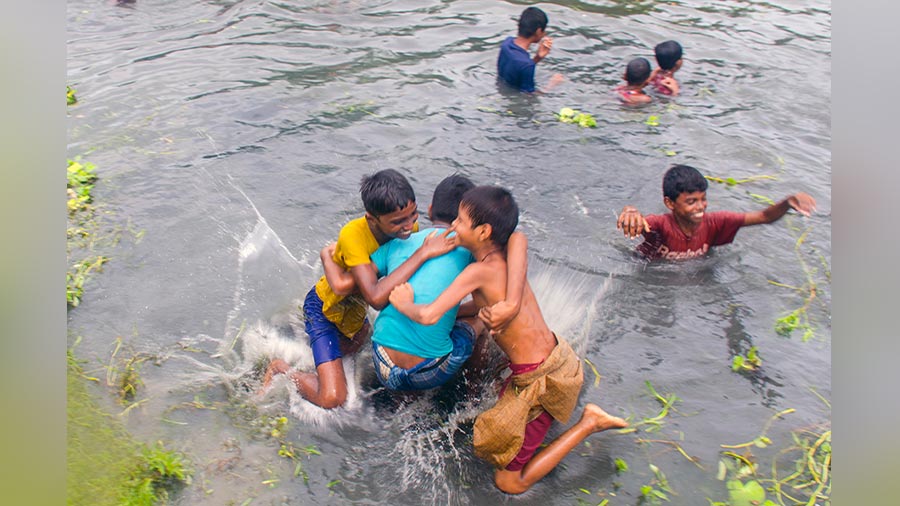
In between the races, kids jumped and swam in the canal
Rangan Datta“The boat races will continue till the end of Durga Puja and several races are scheduled during and after ranna pujo and Manasa puja in the Malancha area,” Bhattacharyya said. Races will be held at Ghusighata on September 19, in Malancha on September 20 and Nazat on September 21.
All these places are easily accessible from Science City. The races take place throughout the day, but are sometimes cancelled without notice. “Here the races take place on Bidyadhari river, which is much broader than the Thakrun Khal and can accommodate more boats. Also the boats are longer and are rowed by about 24 men. The boats move in the direction of the rowers who use a different type of oar called paddle. Proximity to the city and easy accessibility provides the Kolkatans a unique opportunity to witness the amazing rural sports of southern Bengal,” Bhattacharyya added.
